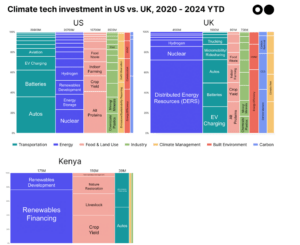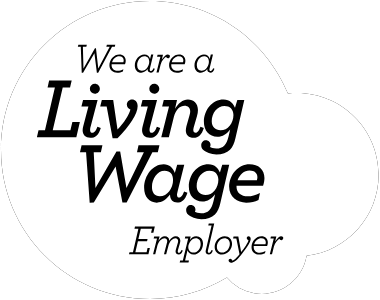Climate Tech Investment: Which sectors are attracting the most capital in the US, UK & Kenya?
Here’s a question for all you people out there: ever wondered where the money is flowing in climate tech these days?
Anyone who guessed that energy, transportation, and food and land use get the most investment: congrats, you’ve gone to the top of the class.
However, when Sightline Climate’s most excellent CTVC took a deep dive recently into market trends across different geographies, sectors and time frames, the regional variations of these verticals told a super-interesting story.

For example, it doesn’t take a particularly beady eye to spot that investment in EVs in the US is going gangbusters, whereas in the UK it’s distributed energy resources investment that is racing ahead.
And in Kenya, it’s all about renewables financing and development. Its equatorial positioning makes it home to super solar potential, and it turns out Kenya is geographically geothermally blessed, too, with more geothermal power capacity under construction than any other country. Yes, Kenya is quite the hotspot these days, with Climeworks, the European poster child of direct air capture, recently revealing plans to develop a plant there, in collaboration with Great Carbon Valley. This would herald the first DAC development of this magnitude in Africa and the Global South.
So we’ll be keeping a close eye on this East African powerhouse – not least because the creation of this kind of regional climate tech ecosystem is definitely what the world needs. However, it will take time for the impact of larger, deep tech innovations such as this to work their way through to the consumer directly. So as we salute the undoubted ingenuity of these gutsy pioneers, we also want to shine a light on those who are using consumer-friendly climate tech innovations to help us lay people make better choices in our everyday lives.
Sustainable household consumption
And boy is this necessary, as, according to Deloitte’s The Sustainable Consumer 2023 survey, consumer spending accounts for over a quarter of all UK emissions. So channelling options for sustainable consumption into consumer habits when people are making their choices on products and services is clearly a no brainer.
So, you heard it people – it’s time to give your lifestyle a sustainability glow-up. And, happily, there’s a raft of climate tech solutions you can look to bring into your daily life, a selection of which we’re now sharing with you here. You’re welcome.
First, it might help to get a handle on where you’re starting from. So go check out Klima, the personal climate action app. Through Klima, you can calculate your own carbon footprint and then offset your emissions through verified climate projects, while also learning how to better shrink your personal footprint.
Precision fermentation
And not that we’re know-it-alls, but we’d suggest that getting stuck into the scourge of global food waste is something we should all be doing. So meet Mill, your sleek new kitchen companion set to munch through all your food waste and, thanks to some judicious integrated sensors and custom algorithms, effortlessly transform your scraps into dried, odourless food grounds – either for use in your garden or as collectable chicken feed.
Indeed, using your purchasing decisions can certainly benefit our pressurised food system. So hurrah for Tomorrow Farm’s Bored Cow milk, the milk alternative made with milk protein from fermentation instead of cows. Currently only selling Stateside, we hope this crosses the pond soon as we’re loving the brand philosophy and sparky tone of voice.
Sticking with climate tech-inspired beverages, your morning coffee ritual might never look the same again now that the skilful synthetic biologists at Minus Coffee have masterminded beanless coffee. Similarly using advances in precision fermentation, they’ve engineered yeast that brews coffee with identical aroma and flavours, but no beans. That’s some molecular wizardry we’re looking forward to trying.
And staying in the kitchen, consider cooking using Zero Acre cultured oil when you’re whipping up your next dish, which purports to be healthier, tastier and way more environmentally friendly?
Then as we dream of garden grazing during those lazy summer days, how about treating yourself to an electric Current Backyard grill which, unlike the average charcoal grill, emits no carbon dioxide? Not to mention that it comes with smart features like Wifi and app-based alerts; what’s not to love about that?
Wind farm co-ownership
In fact, as we’re talking about energy, how about looking at your overall energy supply and switching to renewable energy sources like solar panels or wind turbines? If you’ve ever fancied part-owning a wind farm, now is your chance to live the dream as, through Ripple, you can become a proud co-owner of a wind farm or other renewable energy project. Ripple is making waves (sorry) by looking to democratise energy ownership and make green electricity more affordable and accessible.
Or maybe rooftop solar panels are more your thing; in which case, you’ll need a home battery to store the excess power generated. Well whaddaya know, Anker’s solar panel battery banks work to do this in tandem with complementary solar panels. Or there’s EcoFlow, whose PowerOcean DC Fit retrofit battery storage solution can connect with different types of solar panels and store solar energy during the day to power your entire home overnight. Tidy.
And let’s not forget heat pumps. Quilt has gone the extra mile by helping to make the uptake process as seamless as possible for customers. From planning through to installing, Quilt handles the whole process – tah dah!- giving the precision comfort of central heating and cooling systems, but without any installation hassle. There’s lots of smart tech in action here – and their sleek units are very easy on the eye to boot.
Retrofitting homes
Indeed, if you want a hassle-free, energy-efficient upgrade of your home, check out Furbnow, a start-up looking to simplify the retrofit process for homeowners by offering end-to-end project management support through its Home Energy Plan, all the way from an initial home survey to retrofit planning and then management of energy efficiency upgrades. So, someone else does all the heavy lifting? Yes please.
In fact, let’s not forget that as consumers, we can all play an important role in signalling that we would like to see more sustainable innovation across our lifestyles and in our homes. And we’d argue that extends to encouraging and supporting the use of nature-friendly building materials, too. Mycelium, much? Check out Mykor’s MykoFoam, a carbon-negative building insulation made from renewable industrial residues, mycelium and green chemistry. And a shout-out, too, to Kubik, a company operating in Kenya and Ethiopia, which turns hard-to-recycle plastic waste into low carbon buildings, no less.
Convergence
It certainly feels as if climate tech is now starting to converge with consumer tech in an increasing way; perhaps what we ultimately need is for the two to become synonymous – so it’ll just be ‘the way we do things’ going forward. Of course, subsidies, tax credits and other incentives will play a huge part in creating the right enabling environment to support climate-friendly technology to deliver a more sustainable future. But as communications professionals, we can all play our part in helping to tell the story of these solutions to the world.






